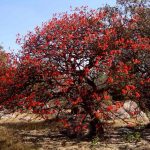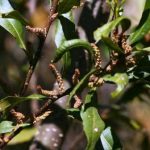TREE LIFE
August 1982
MASHONALAND CALENDAR
Saturday 7th August : 1030 hours. Botanic Garden Walk. The last Saturday morning walk for this year. Meet in the Car Park as usual.
Sunday August 15th : Gilnockie Farm, Arcturus, for many years the home of one of our members, Ms. Peggy Clark. Although we have visited Gilnockie before, on this occasion, we shall start where we left off last time and walk up the river and into the granite kopjes where there is a miniature mermaid’s pool. Bus hired, leaves Monomatapa Car Park at 0900 hours.
Sunday September 19th : Sable Park, Kwekwe. Ever since I became Chairman it has been my ambition to get us together with the Matabeleland Branch and Sable Park, Kwekwe will be a wonderful venue for such a special occasion apart from being almost halfway between Harare and Bulawayo. Sable Park borders on part of Dutchman’s Pool Dam and was given to the residents of Kwekwe and Redcliff by Sable Chemical Industries in the form of a 99 year lease from the Municipality of Kwekwe. And to quote from a letter from Mike Stephens – “They (the Municipality) control the labour and to some extent our finances. The Park is actually run by a Management Committee of volunteers. This group is responsible for game and habitat management, biological records, botanic gardens and development. There is a Field Study Centre with collections and systematic records and a card reference system. Our objective is to provide an interpretative service. We have completed some studies ourselves and others are in progress. A paper was published on the food selected by a giraffe; there is a paper being prepared on termites in the park and also work is being done on a quantitative analysis of the plants available to browsing mammals. Daily duck counts have been made for 11 years and continue.”
When Paul and I visited Sable Park at Easter we were given copies of Check lists of the Mammals, Birds, Fish and Vegetation, the latter listing some 400 species.
I am delighted to say that the Tree Society has become involved in Sable Park by becoming a Life Member. This is a positive demonstration of our support.
I am very much hoping that we still have the support of our members for this trip so that it will truly be a get-together of a very wide membership. We have hired a bus from Harare which will leave the Monomatapa Car Park at 0700 hours and the fare will be $15 which is the same as the regular Express Motorways return fare to Kwekwe from Harare and taking into account the cost of petrol only it would probably be $40 to $50 for the average car so although the price at first seems to be a little staggering I believe it to be realistic. In order to cover costs we will need to have a full complement of 36 passengers on the bus. Usually when we calculate the fare we do so on about 30 passengers, so if there are more we make a profit and if there are less we make a loss. I have never budgeted to make a loss and the committee quite agree that we should not do so now. They have wholeheartedly given their support to this trip to Kwekwe. I hope you will too. It will be an historic occasion and we should have a full bus.
Learner group : There will be a meeting on Saturday 28th August. If you would like to join us on this occasion please contact Mrs Gill Masterson on 303435 between 0630 and 0800 hours or in the evenings.
BOTANIC GARDEN WALK 3RD JULY 1982
Although Saturday 3rd dawned cloudy and cool, which may have accounted for the lower than usual number of walkers at the Botanic Garden, by the end of the morning we were all commenting on how like a September day the weather had become. (The Sunday which followed was the day when there were records broken for the lowest temperatures ever recorded in some parts of the country). Mr Tom Muller was our leader and in the main we had a look at the trees usually associated with mopane woodland although very often the stand of mopane is pure with short grass and is very park like.
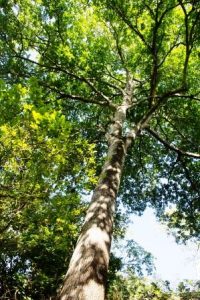
Berchemia discolor, bird plum. Photo: Rob Burrett. Source: Flora of Zimbabwe
Firstly we looked at Berchemia discolor, bird plum. This is a member of the family RHAMNACEAE and its leaves are both alternate and opposite, being alternate near the base of the shoot and sub-opposite to opposite at the ends. The main feature are the regularly spaced veins, not always opposite as we subsequently discovered, which run rather steeply to the margin and are very conspicuous particularly on the pale under surface which is why it is called discolor. (In January at Circular Drive, Bulawayo, Paul and I were introduced to B. zeyheri, Red Ivory, which had much smaller leaves with a very white under surface but I presume it was named subsequently to B. discolor). We noticed two features which Tom was inclined to discount but which I think we must look for. There appeared to be a conspicuous growing tip and the petiole was grooved or sulcate. Berchemia discolor occurs along rivers and in riverine fringes at the low altitudes and on anthills at medium altitudes.
Other mopane associates we looked at were Terminalia prunioides with its small leaves borne on lateral spurs; Commiphora pyracanthoides which has the anomaly of having compound leaf with a single leaflet, although occasionally in young leaves one can see tiny lateral leaflets which drop off when the leaf matures. This has a trunk and bark looking like a cross between Commiphora marlothii, peeling bark Commiphora and C. africana, with a tiny little peel or flake revealing the green underneath; Combretum apiculatum unmistakable, as long as one remembers to look at apiculate leaf apex; Erythroxylum zambesiacum which looks so very like Securinega virosa. In fact at one stage Tom nearly had us convinced that the one was in fact the other! However, in the end we did get it sorted out. E. zambesiacum has a flattened stem and growing tip just like E. emarginatum with which we are much more familiar; Gardenia resiniflua, with very wrinkled leaf is one which has escaped the recent name change exercise; Balanites aegyptiaca with its twined leaves.
And then, of course, we had a look at Mopane itself, to give it its full name Colophospermum mopane. The leaves are compound but arise very close together and if you look carefully between the two large leaflets you will find a very small third vestigial leaflet. Just for fun we had a look at the Guibourtias which are very close relations without the vestigial leaflet.
Thank you Tom for the taste of mopane woodland. I wonder which of the species we shall see at Chegutu?
STANLEY FARM CHEGUTU 18TH JULY 1982
Our trip to Stanley Farm, Chegutu, home of the Watkins family since the early part of the century proved a special treat for the Tree Society. Whether one wanted to know the identity of every leaf, learn the names of a few more trees or merely walk in mopane woodland I believe all our souls were satisfied.
On arrival we were greeted with tea; at least that was what it was intended but we had to pass THE FIG TREE and what Tree Society member could walk past such a tree. It has at least 12 branches running parallel to the ground slightly above head height with a circumference of 36m. This Ficus sansibarica, large-fruited Fig, had been a strangler next to the calf pen in 1926. There is now no sign of the Mfuti, Brachystegia boehmii which was its original victim. Although the figs, up to 5cm in diameter, which occur in pairs along the branches are reported to be edible, the Watkins have found them of no value at all and even the pigs have scorned them. The oblong leaves are borne on very long petioles and this, with the size of the fruit makes identification unmistakable.
So then we hurried to the homestead of Brian and Jennifer Watkins where we had a quite magnificent tea and eats before we re-boarded the bus which took us out to the start of our walk and then returned to the homestead. Brian set the scene for us: Stanley Farm, when acquired by his father had been chopped out to supply timber for nearby mines so what we would be looking at was about 70 years of growth. We were on contact soils at an altitude of 3960 feet (1 000m) and an average rainy season was 686mm or 27 inches.
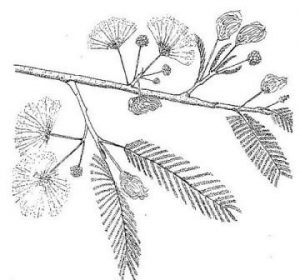
Albizia amara. Drawings by Patricia Bingham. Flora of Zimbabwe
Our first discussion centred around two trees, the leaves of which were too high up to examine and the pods lying on the ground may have blown over from a tree nearby. At the time I said I thought they were Acacia goetzei subsp. goetzei. We were able to lasso a couple of leaves using my weighted string and I was presented with the facts that there was a gland on the petiole and that the leaflets were sickle-shaped, and had to concede that it may well be an Albizia. From the bus on the way home we saw lots of Albizia amara, quite unmistakable, and by the time we reached Selous I was quite convinced that if those trees at Stanley Farm were Albizias then they were not A. amara. Since then I have consulted the literature and am even more convinced that they were Acacia goetzei which has leaflets that are usually asymmetric at the base. Albizia amara has straight leaflets which separates it from A. harveyi. However, A. harveyi has long strap like characteristic Albizia pods. The answer lies in the flowers which is the first point that needs to be followed up during a return visit.
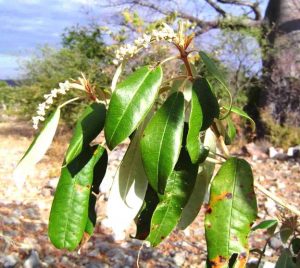
Croton gratissimus, lavender Croton. Photo: Rob Burrett. Source: Flora of Zimbabwe
Berchemia discolor, bird plum, stood out beautifully with its light apple-green leaves sharing an anthill with Diospyros mespiliformis, ebony Diospyros, densely leafy, a much darker green and its growing tip satisfactorily obvious and characteristic. In the meantime a Sausage Tree had been spotted and we went back to find it. This proved to be a most fruitful exercise. There was Croton gratissimus, lavender Croton with a 7 inch diameter trunk, unlike the bushes we usually see, it had been struck by lightning and was broken in half. As to be expected it was in bud, which appear as early as February although it does not flower until September/October, then it flowers and fruits in a hurry and is in bud again by February. The leaves were dry and old but they still had enough Lavender scent to give truth to the common name. Indeed, this is one of our beauties, its leaves have a shiny green upper surface and a silvery white under surface dotted with cinnamon coloured glandular scales, they droop on longish petioles and frequently there is a reddish leaf among the green and silver.
Strychnos potatorum, its leaves now yellow and mostly on the ground had us worried for a moment when we noticed its Grewia-like fruit; however, once we had sorted out the stems and branches we were able to establish that a Grewia and a Strychnos were intertwined. The Grewia was a puzzle as it had very square stems and and very square leaves. Specimens brought back to the Herbarium have proved it to be Grewia flavescens, our familiar Donkey Berry as its square stems signified, but it was var. olukondae (no wonder when Mrs.Gill Masterson told me about this she declined to pronounce the name although since then we both have got our tongues round it).
There were also Friesodielsia obovata with hardly any leaves but the few remaining obovate, upside-down egg-shaped and unmistakable with their pastel blue green under surface. Better specimens were seen in the afternoon.
We found our Sausage Tree and several collecting bags became suddenly much heavier. The Sausage fruits are supposed to be a cure for skin cancer, the most common method being to cut a slice or nick out of a piece and rub it on the affected spot. For those who do not have a Kigelia africana in the garden the suggestion was made that the fruit could be kept fresh in the refrigerator.
Capparis tomentosa, its beautifully velvety leaf confirming that tomentosa means “covered with matted hairs” , it is not something we often encounter and as a bonus, it was also in flower. It did have 4 sepals and 4 petals but the central mass of stamens were spectacular. There were several odd fruit so, by piecing the pieces together, we were able to get an idea of what they are like. For those who found it thorny let me reassure them that those were merely spinescent stipules and not thorns at all. The pickled flower buds of Capparis spinosa, an inhabitant of the Mediterranean areas provides the capers famed as an ingredient for sauces.
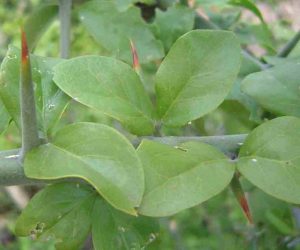
Balanites aegyptiacum. Photo: Rob Burrett. Source: Flora of Zimbabwe
Balanites aegyptiaca with its straight thorns and paired leaves was our next find. This is supposed to have been grown in Egypt for the last 4000 years on account of its edible fruit and seeds which have been found in a Pharaoh’s tomb, presumably put there as food or to light his way in the eternal darkness. The seeds contain a good quality oil which burns with a bright flame and the kernels are sometimes used as torches. The Common name torchwood comes from this. The fruits are edible but not very palatable and are very poisonous to aquatic life thereby providing a good fish poison and an anti-bilharzia solution. Balanites maughamii, a lower altitude species, has thorns that twin at the tips forming a Y. Carissa bispinosa also has very similar Y thorns but, together with C. edulis (straight thorned) it has simple leaves and a milky sap whilst the paired leaves of the Balanites are quite distinctive.
The question we took with us to lunch was about the Dwarf Ochna which we found amongst an outcrop of rocks as single leaves growing out of the ground. Are they really Ochna macrocalyx or are they in fact tree species bonsaied by the rocks. Going by the serrations on the leaf margins, they were not Ochna pulchra which we had seen near Cleveland Dam as a dwarf species growing under adverse conditions and the leaves were too large to be Ochna puberula. So it only leaves O. schweinfurthiana and in Flora Zambesiaca the margins of the leaves of both this and O. macrocalyx are described as “serrulate”. Unfortunately we only started asking questions afterwards and gave no thought to collecting a piece for identification. Another reasons for a revisit.
As we walked up to the tractor and trailer waiting to take us back to lunch there was a Pseudolachnostylis maprouneifolia in magnificent autumn tints, the sun slanting through the leaves emphasising the colour. One of our next members commented that she called this the Kudu-berry and no-one argued with her.
Over to our left was a Combretum fragrans and further on a Combretum imberbe with its very grey green wrinkled leaves and to add to the Combretum picture was C. hereroense, its leaf just the shape of a mouse ear, but it was glabrous, bald and not velvety as it is supposed to be. And as the tractor wended its way home we had to duck our heads under an Acacia gerrardii in full pod, the pods rather sickle-shaped in unbelievable profusion, dripping their seeds by a delicate string.
At lunch, taken sitting on the sweeping green lawn, we were offered a mug of soup and in spite of the weather being warmer than anticipated, there was a chilly wind and we all partook and thoroughly enjoyed the extra luxury. It really was a treat.
After lunch we made our way round to the back of the house outside the security fence. Some braved the climb up the kopje and others wandered down the cattle trail and a couple of members rushed off to go back and walk again in the mopane woodland. For those who ventured up the kopje there was excitement indeed! The Pod mahogany, Afzelia quanzensis, in pod but they were still high up the tree and none accessible on the ground. Boscia salicifolia with its long slender leaves “like Salix”, the willow, with their distinctive yellow midrib prominent on the under surface. Hippocratea parvifolia seen recently at Ijapo Estate, Gadzema, not very far away. I am not sure what the twining encircling tendrils are, they are probably not stipules as those fall early, perhaps they are modified branchlets. The feature of Hippocratea is that it appears as though there are simple and compound leaves on the same plant. The reason for this is that the axillary bud, the bud in the axils of the simple leaves, is inclined to do its own thing and to sprout into a shoot with opposite leaves looking like the leaflets of a compound leaf. Perhaps really more of a climber or liane than a tree these had trunks more than 5cm in diameter and were well above head height albeit leaning against another tree and could only be classified as trees.
As we were admiring the Hippocratea and moving on to the next one to drool over, Mrs. Gill Masterson spotted what we thought at the time was the find of the day, Haplocoelum foliosum. Both Gill and I have seen it but once before at different localities, and the excitement was tremendous. This is a member of SAPINDACEAE, the other members of which we saw being Allophylus africanus, Pappea capensis, Zanha africana. Haplocoelum foliosum, ‘foliose’ means with many leaves, has a pinnate, once compound leaf with 3 – 14 pairs of opposite leaflets, which are very asymmetric, so much so that the midrib appears to run diagonally across the leaflet instead of down the centre. The one that Gill first saw was rather small but further on was a little group about 3m high with 7cm diameter stems.
And then there was the thing that looked a little like Rhamnus, but that story I shall tell you at the end. In the Herbarium.
As we came down on to the cattle track there was a plant with a trifoliate leaf, the petiole sticking up and the leaflets hanging down. This was Maerua triphylla, a member of CAPPARACEAE as are the genera of Boscia and Capparis which we had seen earlier.
And all the trees I have not mentioned without even having to refer to my list which says that there were a total of more than 80 species recorded for the day, many lovely old friends come to mind.
A very very sincere thank you to Brian and Jennifer and to Meryl Watkins, Brian’s mother, for sharing your beautiful, exciting and unusual trees with us. We loved every minute and every leaf and were most appreciative of the tea, coffee, soup and eats at random. And thank you too, to Mrs. Anne Bianchi who must take full credit for setting up the whole thing.
And the plant that looked like Rhamnus? It was in fact Maerua freisii and we have not even thought of a common name for it as in common with you we have never heard of it before, which is not really surprising as this is only the second time it has ever been collected in Zimbabwe! Maybe it should have an uncommon name!
-Meg Coates Palgrave
MATABELELAND CALENDAR
August : There will be no field meeting on the first Sunday on account of the drought. A social evening has been arranged for Tuesday 3rd August at 1930 hours at the pavilion, Milton High School. Films will be shown by courtesy of the Zionist Organization.
September : Sunday 19th September – a day spent a Sable Park, Kwekwe for all Zimbabwe Tree Society Members. There is a chance of seeing the lovely spring foliage on the Brachystegia trees.
October : Sunday 3rd. Field meeting according to the security situation at the time.
-Meg Coates Palgrave Chairperson


